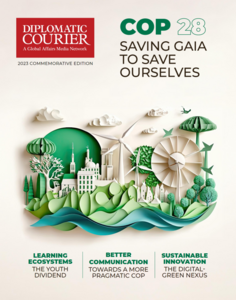
Four UNU-MERIT researchers (Sanae Okamoto, Shyama Ramani, Rasmus Lema and Alejandro Álvarez-Vanegas) have co-authored articles for a COP 28 bookazine from the global affairs media network Diplomatic Courier, entitled COP 28: Saving Gaia to Save Ourselves.
This special edition, which was published on 21 November 2023, focused on three main questions:
– How do we craft better collaborative learning ecosystems to better equip youth and adults to address the climate crisis?
– How do we better communicate about climate change—with global publics and between governments—to foster trust and cooperation?
– How do we identify what long-term sustainability technological innovation looks like, and encourage those innovation paths?
Our researchers helped to answer these questions by writing about topics as diverse as the Quadro Helix Model, natural language processing tools and the digital revolution. Here, we share three excerpts from each of their articles.
The Digital-Green Nexus is a Win-Win for the Planet and the Economy
By Carlota Perez and Rasmus Lema
This year’s UN Climate Change Conference (COP28) in Dubai will conclude the global stocktake exercise, assessing global progress on mitigating climate change. As it will show, most countries have formulated national plans for reducing emissions, often combining existing technologies with those that are expected to develop during the current window to limit global temperature rise to 2°C. These plans are often too optimistic.
While many policymakers believe in a hockey stick-model of climate change mitigation in which they can await innovative technologies and cost reductions—and thus only achieve the bulk of reductions at the end of this decade—there is a real risk that mitigation actions will follow a flatline curve instead. There are also enormous technological uncertainties, and investments are mainly incremental improvements in existing technologies or in new green technologies which have been “immature” for decades. With only six years left to go until the end of the Paris Agreement’s timeline of 2030, where should countries direct their efforts of technological innovation in support of reaching climate targets and major long-term transformation?
A “Twin Transition?”
The notion of the “twin transition” brings the information revolution into play, acting as the enabler as well as the reinforcer of the green transformation. Most green technologies have limits in terms of the technological multiplier effect of investments in technological innovation; they are extremely diverse in terms of their science and technology groundings, and there are few synergies between them. Improvements in wind energy technology do not have knock-on effects leading to improvements in, say, solar, low-carbon steel or green aviation. Conversely, digital technologies are internally dynamic and mutually reinforcing in terms of technological change, and they have an enormous green potential. Thus, the idea of the twin transition is both misguided and right. It is misguided because there is no two-way interaction: green technologies do not lead to any dynamic improvements in the digital economy. Yet it is right because digital technologies—while often overlooked in climate mitigation discourse—are in fact the main source of much green technological change.
[Read the full article here.]
The Mental Health Challenge of Climate Change
By Sanae Okamoto and Nidhi Nagabhatla
Climate change impacts our mental health both directly and indirectly—directly as global publics cope with the trauma of sudden climate events, and indirectly as the more we learn about climate change, the more we worry. The lack of progress in global climate action is distressing, particularly for youth and children, and raises concerns for future generations. Inevitably, climate change is affecting the environment and our wellbeing. Yet, even apart from the impact of climate change on mental health systems around the world, governments are only allocating an average of 2% of health budgets to mental health. Climate change will likely intensify the situation due to the dearth of effective services and the overarching stigma connected to mental health which augments the suffering of those distressed—especially in underserved settings.
Addressing these complex challenges will require a multifaceted approach that includes empowering youth and adults with the knowledge and skills needed to act. To craft better collaborative learning ecosystems, we must integrate climate education into the existing school curriculum. In 2025, the Programme for International Students Assessment (PISA) will consider evaluating the extent of 15-year-olds’ comprehension of climate change and their abilities to tackle climate challenges at both local and global levels. However, teaching climate change in schools would raise another fundamental question. Would we be scaring them with these facts about climate change? Such emotional effects can’t be neglected. This necessitates smart strategies to equip young individuals with the psychological resilience to confront the escalating risks.
[Read the full article here.]
A Real-World Approach to Education in Times of Climate Change
By Shyama Ramani and Alejandro Álvarez-Vanegas
Since UN Member States adopted the Sustainable Development Goals (SDGs) in 2015, many efforts have been made to design pathways and avenues to see their achievement. SDG 4 on quality education is no exception. However, higher education institutes (HEIs) are struggling to integrate sustainable development into their curricula and classrooms. A better approach to foster cooperation between state governments, HEIs, firms, and NGOs is offered by the Quadro Helix Model. This model facilitates learning, including experiential, to young people in real time—particularly in countries facing serious climate risk.
Since 2002, UNESCO has influenced and supported a global framework for Education for Sustainable Development (ESD). ESD calls for an expansion of education and exploration of diverse pedagogical strategies which will develop the required socio-emotional and behavioral values, attitudes, and social skills to deal with global challenges such as climate change. However, HEIs’ main perceived function is to deliver employability in a business-as-usual economy, rather than promote civic responsibility. Furthermore, academics are pushed to publish and patent rather than engage in societal outreach. Given these pressures, breaking HEIs out of their traditional role requires additional incentives be offered to do so.
Enter the Quadro Helix Model, a framework proposed to implement sustainability transition programs such as ESD. A more commonly known model, the Triple Helix Model, differs in that it calls only for cooperation between academia, the private sector, and the government. Whereas the Quadro Helix Model adds a fourth player: NGOs—specifically in the innovation ecosystem—to generate societal innovations and motivate transformation with the support of the state, academia, and firms. As such, it’s more geared toward the objective of changing minds and behaviors about social targets like climate resilience.
[Read the full article here.]
ANY COMMENTS?
NOTA BENE
The opinions expressed here do not necessarily reflect the views of UNU.
MEDIA CREDITS
Photo by UNclimatechange on Flickr (cropped) and bookazine cover page image sourced from Diplomatic Courier




